CUMULUS MEDIA | Westwood One Audio Active Group’s Audio Creative Best Practices: The Blueprint For Developing Impactful Ads
Click here to view a 13-minute video of the key findings.
When it comes to audio creative, there are a few commonly asked questions. What are best practices? Is a thirty-second ad better or worse than a sixty-second ad? What is the difference between a host-read ad versus a pre-recorded ad?
The CUMULUS MEDIA | Westwood One Audio Active Group has tested hundreds of audio ads over the years working with the leading experts in creative testing: ABX, Veritonic, and Sensory Logic. The findings from those tests, along with marketing effectiveness and creative strategy work from industry giants like Les Binet, Peter Field, Alice Sylvester, Byron Sharp, Leslie Wood, Paul Feldwick, Jenni Romaniuk, and Orlando Wood, have been combined to form CUMULUS MEDIA | Westwood One Audio Active Group’s comprehensive Audio Creative Best Practices.
When developing creative, keep these strategies in mind for high quality audio:
Ad length plays a minor role: The most asked question has the smallest impact on marketing effectiveness
The most frequently asked question about creative is about ad length. 15-second ads versus 30-second ads versus 60-second ads. Which is better? This question is often asked without any context.
Creative tests show only a modest benefit between 30-second ads versus 60-second ads. Hundreds of podcast brand effect studies conducted by Nielsen find 30-second ads achieve nearly the same ad recall and purchase intent of 60-second ads.
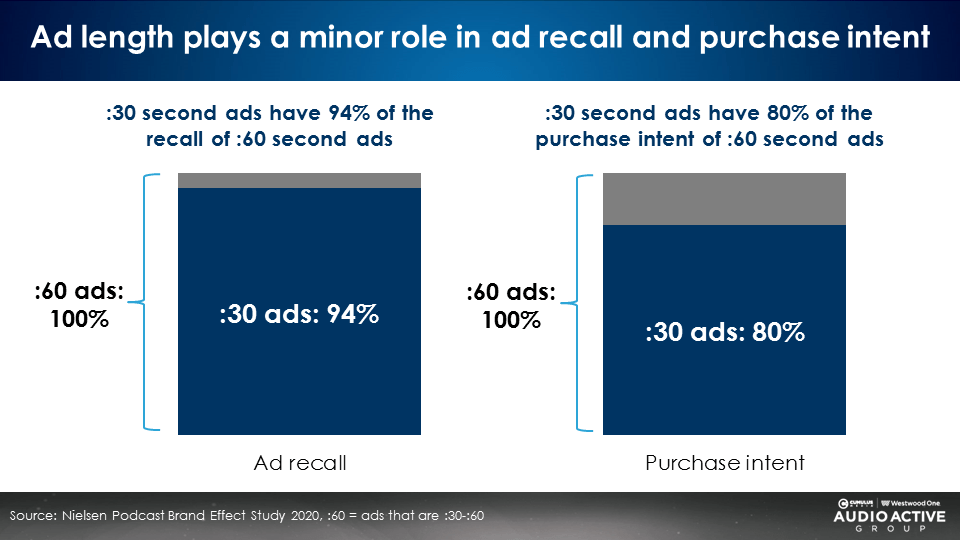
Don’t get caught up on spot length. In the grand scheme of audio creative, the length of an ad is a minor factor in effectiveness. Instead, focus on the number of messages included, the mix of brand building and sales activation, and utilizing emotional copy over rational messaging to influence the effectiveness of creative.
Don’t worry about wear-out
Wear-out is the point where creative performance declines by 50% from its peak. This occurs because of listener fatigue due to message frequency in a continuous time period.
The best way to avoid wear-out? Develop quality creative. The better the audio creative, the longer the ad can run. Pre-test the audio and then test it again in six months. If the creative is high quality, the scores will be stable.
In their book How Not To Plan: 66 Ways To Screw It Up, Les Binet and Sarah Carter report on the non-issue of wear-out: “Millward Brown concludes that genuine wear-out is rare, and limited to ‘new news’ ads. Campaigns are more likely to wear in than out.”
The fewer messages, the better the advertising recall
Creative testing giant Millward Brown reports the more messages an ad attempts to convey, the lower the likelihood of a single message being communicated. Their data shows that the first message in an ad with four messages has only 43% of the recall of an ad with one message.
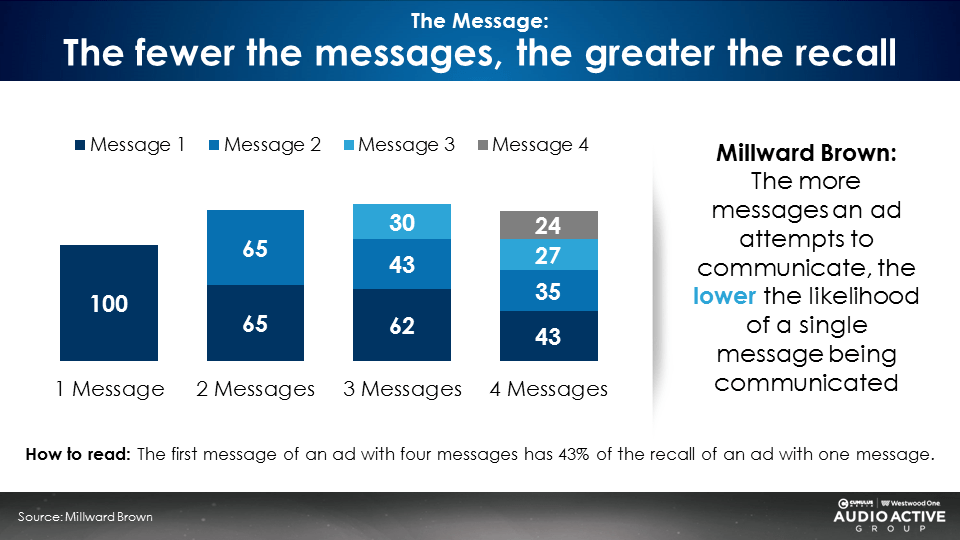
The more messages crammed into an ad, the less likely consumers can recall the messages. A 15-second ad with one simple message will generate better recall than a 30-second ad with three or four messages.
Chris Smith, Principal and Chief Creative Officer at Plot Twist Creativity, advises his clients with his own audio creative best practices including: “Be single-minded: say one thing.” He explains, “A lot of advertisers think that because radio affords you sixty or thirty seconds, they have the time to say everything there is to say about their brand. It’s why so many commercials end up sounding like laundry lists. The truth is, if you want to talk about everything, then you really have nothing to talk about. In advertising, you need to have one thing to say. AM/FM radio’s sixty seconds of ad time just gives you the chance to say it in an entertaining and memorable way.”
He cites this Snickers ad to illustrate the point: “They have one idea – you’re not at your best when you’re hungry. They spend most of the ad being entertaining, holding the attention of the audience, and serving the one central idea.”
Prioritize brand building over sales activation at a 60/40 ratio
Les Binet, Head of Effectiveness at adam&eveDDB, and Peter Field, Marketing Consultant, studied the IPA Databank, the world’s largest database of marketing case studies for their book The Long and the Short of It: Balancing Short and Long-Term Marketing Strategies.
Based in London, the Institute of Practitioners in Advertising (the IPA), maintains the IPA Databank of over 1,200 case studies submitted to the IPA’s Effectiveness Awards Competition. Covering a broad spectrum of marketing categories and budgets, they “represent the most rigorous proofs of the effectiveness of marketing communications in the world.”
Binet and Field, “the godfathers of marketing effectiveness,” explain that the goal of sales activation “is to focus on people who are likely to buy in the very near future. That means exploiting existing brand equity to generate sales right now.”
Sales activation campaigns are the “carbs of advertising,” producing a sugar rush of short-term sales and then a crash
Sales activation features rational copy and tight targeting. In their book Media in Focus: Marketing Effectiveness in the Digital Era, Binet and Field report that “activation effects are relatively easy to measure, because they tend to be big, immediate and direct. In the short term (six months or less) they tend to produce the biggest sales responses.”
Binet and Field show how sales activation campaigns (the grey line below) generate sales uplift through a series of short-term sales spikes that quickly collapse.
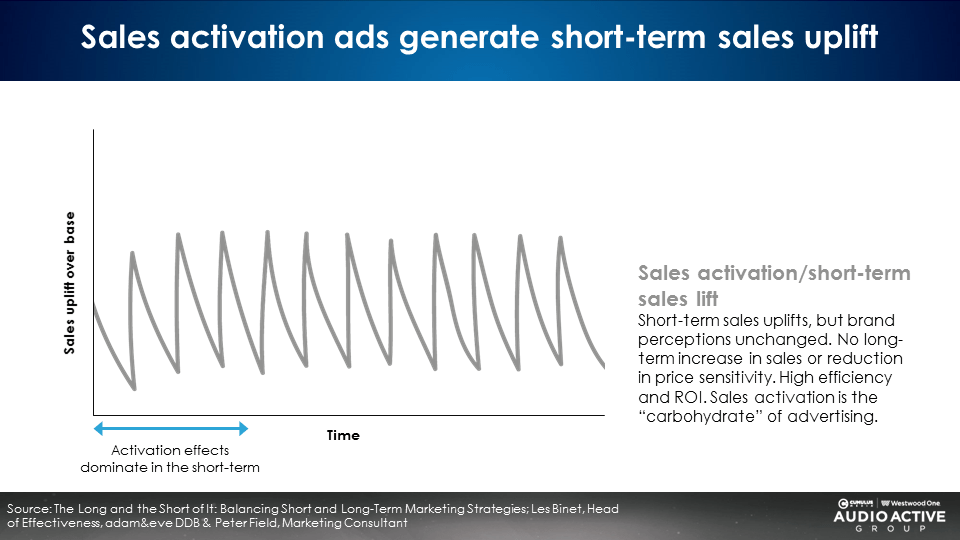
Brand building campaigns, the “protein of advertising,” overperform sales activation
Analytic Partners, one of the world’s largest and most prestigious marketing mix modelers, reveals that brand messaging outperforms performance messaging 80% of the time. Of the two types of campaigns, brand building is harder to achieve, requires greater investment, and is more important.
According to Binet and Field, “Brand building means creating mental structures (associations, memories, beliefs, etc.) that will pre-dispose potential customers to choose one brand over another. This is a long-term job involving conditioning consumers … so it takes time; talking to people long before they come to buy.”
Brand building requires mass reach media like television and AM/FM radio because the goal is to target everyone in the category, even if they are not in the market right now. While short-term sales uplifts are smaller, brand building sales effects (the blue line below) grow and grow over time, becoming the main driver of long-term growth and profit.
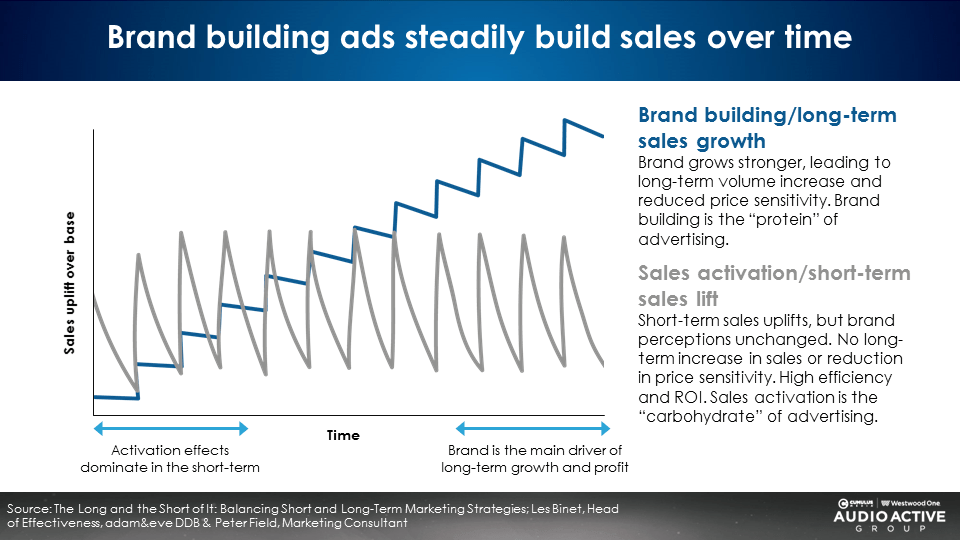
Binet and Field report the sales effects of brand building “decay away more slowly … In the long run, brand effects are the main driver of growth.” Binet and Field find that the ideal mix of marketing investments should be 60% brand building and 40% sales activation.
Focus creative on emotional messaging versus rational
Building top of mind recall and brand awareness is all about reach. Ensuring that a brand is liked and understood is the job of brand advertising. Are brands built with facts and logical assertions or with emotion-based storytelling?
The Binet and Field analysis found that emotional campaigns build brands more strongly regardless of the measure: awareness, commitment, trust, differentiation, fame, or image. Emotional campaigns are far more powerful at building brands. They create emotional bonds and associations.
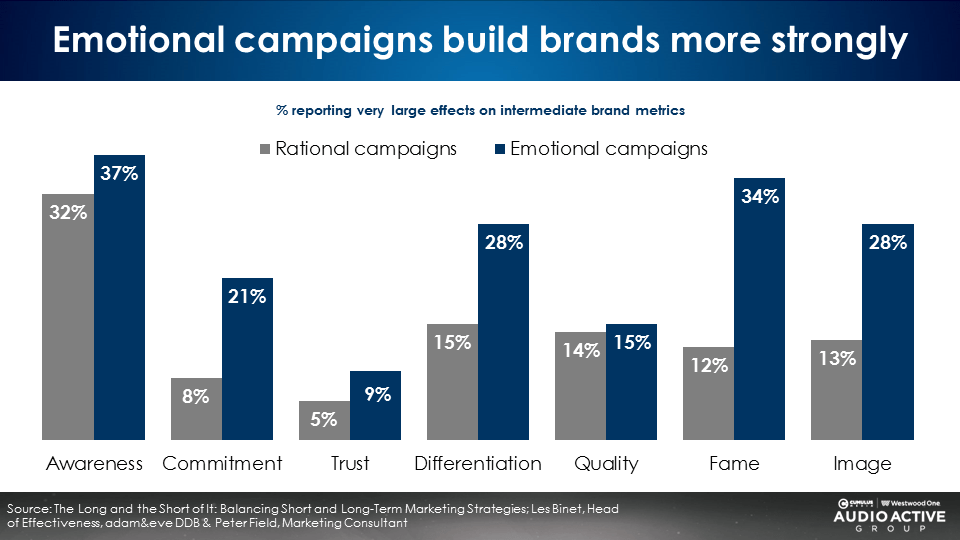
What about concrete business outcomes like sales, profit, and share? Binet and Field found emotion-based advertising generates stronger business results for these outcomes as well.
Emotional campaigns drive higher long-term sales, share, pricing power, and loyalty. Over time, Binet and Field found that emotional campaigns are more profitable: “Emotional campaigns’ effects last longer than rational ones and so build more strongly over time: this is especially true of profitability, because of the multiplier effects of emotional campaigns, on both volume and pricing.”
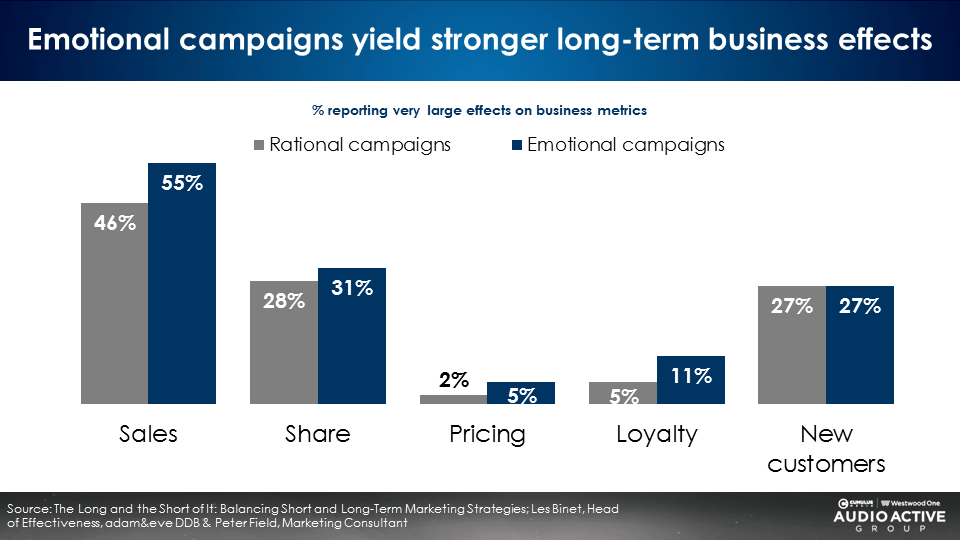
Write to Engage: Sensory Logic’s 18 Principles of Engagement
Sensory Logic, a creative evaluation firm, uses facial recognition to measure consumers’ real response to advertising. This technique uncovers people’s true feelings as most opinions and decisions are made unconsciously and not rationally. Based on all of their testing, Sensory Logic has developed 18 Principles of Engagement, explained through a series of short video trainings.
Use a fluent device, ie. a recurring character or scenario
Orlando Wood, Chief Innovation Officer of System1 Group, one of the world’s leaders in creative testing, published a much-lauded book, Lemon: How the Advertising Brain Turned Sour. Wood defines a fluent device as:
- A fictitious character or characters (human or creatures) created by the brand and used as the primary vehicle for the drama in more than one ad across a campaign (ie. GEICO’s gecko)
- A scenario, expressed as a slogan, used more than once in a campaign as the primary vehicle for the drama without which the ad would make little sense (ie. “You’re not you when you’re hungry!” from Snickers)
Campaigns using a fluent device are much more likely to achieve market share and profit gain than campaigns without.
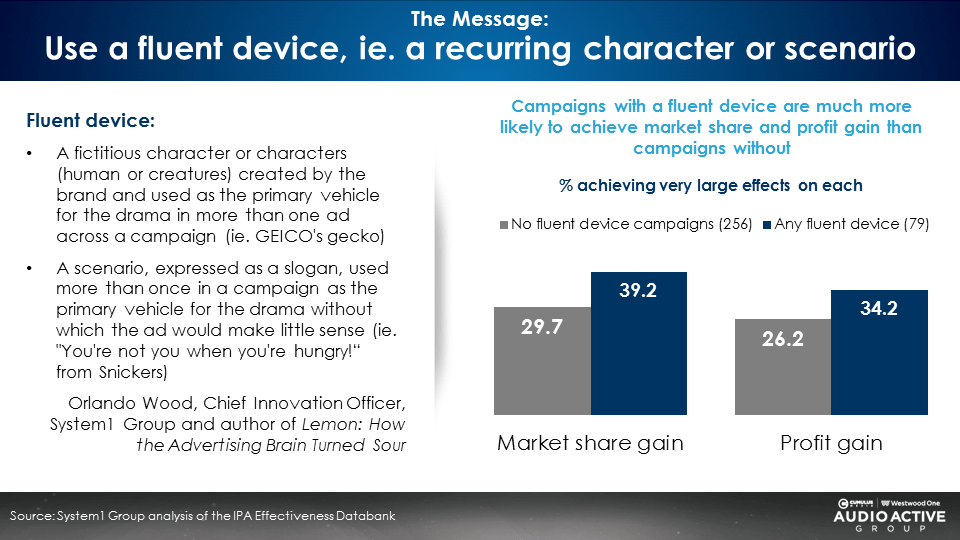
Entertain for gain: Memorable ads have showmanship and salesmanship
In Paul Feldwick’s new book, Why Does The Pedlar Sing? What Creativity Really Means In Advertising, he advises, “Embrace the idea that advertising is at least as much showmanship as it is salesmanship. It is time to rediscover the fact that advertising builds brands best when it is entertaining, popular and memorable, when it is not just a pitch, but a performance.”
Howard Luck Gossage, the advertising visionary frequently referred to as “The Socrates of San Francisco,” said, “The buying of time or space is not the taking out of a hunting license on someone’s private preserve, but it is the renting of a stage on which we may perform.” Orlando Wood says it best, “Entertain for gain.”
The first five seconds matter: Say the brand early and often
Say the brand name within the first few seconds of the ad. What’s the first word in any GEICO AM/FM radio ad? “GEICO presents…” Hundreds of Nielsen brand effect studies reveal the more brand mentions in an audio ad, the greater the ad recall and the stronger the familiarity, brand affinity, and likelihood to seek information.
Women prefer a female voiceover
The majority of audio ads are voiced by men. Why? “That’s what we’ve always done,” is not a data-based rationale. A series of studies conducted by CUMULUS MEDIA | Westwood One, Veritonic, Nielsen, and ABX found that women prefer female voiceovers. Female-voiced ads perform as well or better among men.
Make the ad audible and easy to understand
ABX creative testing examines an ad’s message delivery, clarity, and ability to be understood. Ads that test poorly on these measures tend to have a fast-paced nature or noisy background music which make it hard for listeners to understand of the dialogue.
For effective creative, pace the script so that it can be easily understood, make sure it is audibly clear, and keep the content simple and intuitive. Put speaking voices in the foreground and make sure music and background effects do not overwhelm them.
Use music for branding
Lauren McGuire, President of Made Music Studio, says, “If music creates emotion, what we see is brand favorability increases, brand consideration increases, metrics that really apply directly to ROI. When it comes to all experiences, brands are realizing that emotional connection is more important than ever.”
In their book How Not To Plan: 66 Ways To Screw It Up, Les Binet and Sarah Carter report, “Ads using music prominently are significantly more effective than ads that don’t, enhancing effectiveness by 20–30%.”
Use a sonic logo with melody that says the brand name
Veritonic, the leader in audio creative research and analytics, says sonic logos that have melody and say the brand name test better and have far stronger association to the brand.
Byron Sharp, author of How Brands Grow: What Marketers Don’t Know, says the key to success is creating consistent and constantly-used easy-to-remember brand assets which will over time create distinctive memory structures which bring the brand front-of-mind when a consumer is shopping that category.
Pitfall: Brand ads masquerading as performance ads
A common mistake is to measure site attribution with a brand ad that only says the website once in passing. Often advertisers new to audio use a brand ad but then measure the campaign with site and search attribution. If the objective of the ad is to drive search and site traffic, the AM/FM radio copy has to mention the website three to five times and say the brand name a lot.
Match the measurement to the creative. Measure brand campaigns with a brand lift study. Performance ads that repeat the brand and website frequently are measured best with search and site attribution.
Common mistake: Not branding early and often
A frequently seen issue in audio creative are ads that do not have the brand name in the first three seconds and do not say the brand frequently in the ad. A common TV ad practice is to create a mysterious scenario, keep people guessing for 28 seconds, and then put up the brand logo in the last two seconds of the ad. Do not make this mistake in audio. Brand early and often.
Key takeaways:
- Have a conversation: Don’t shout
- The first five seconds matter: Say the brand early and often
- Don’t get caught up on spot length
- The fewer the messages, the greater the recall
- Use consistent, unified creative across different media to deliver impact
- Tell a story with emotion
- Use a fluent device, ie. a recurring character or scenario
- Entertain for emotional gain
- Make the ad audible and easy to understand
- Use music for branding
- Create a sonic logo with melody that says the name of the brand
- Leverage the appeal and trust of AM/FM radio personalities and podcast hosts
- Target your core audience: Women prefer a female voice
- Don’t worry about wear-out
Click here to view a 13-minute video of the key findings.
Download Cumulus Media | Westwood One Audio Active Group®‘s full guide to Audio Creative Best Practices.
Pierre Bouvard is Chief Insights Officer at CUMULUS MEDIA | Westwood One and President of the CUMULUS MEDIA | Westwood One Audio Active Group.
Contact the Insights team at CorpMarketing@westwoodone.com.